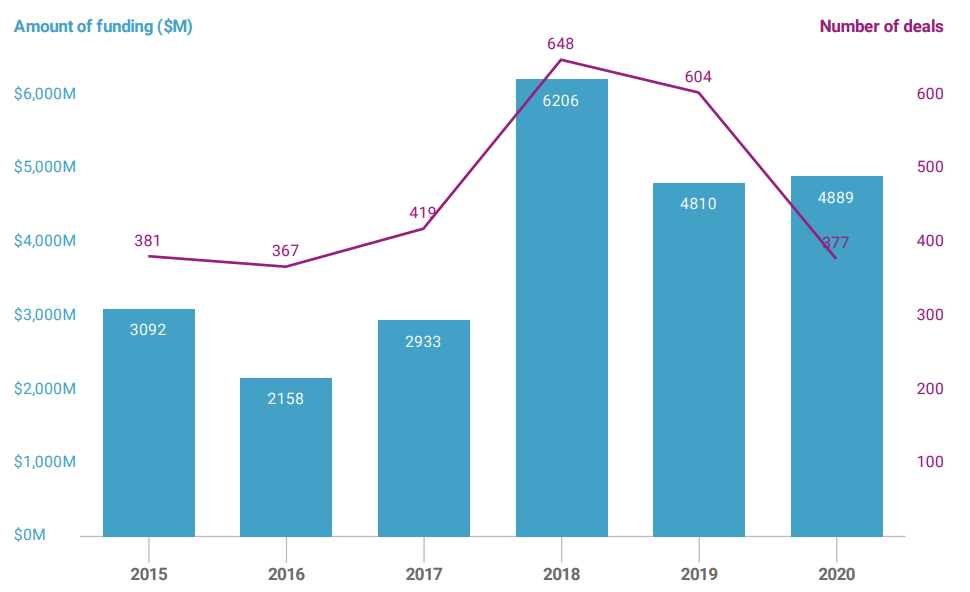Poland is becoming an important European tech ecosystem after experiencing record levels of investment and growth in recent years.
It’s the largest economy in Central and Eastern Europe (CEE), is known for its technical talent and has now nurtured a number of large startups that have raised multiple rounds of funding. In 2019, investment in Poland’s startups — with Warsaw being the biggest startup hub in the country — grew eight times year-on-year to reach €294 million. This was more than the combined amounts of the nine years prior. While investment has slowed due to the pandemic, it has not stopped. And of course, COVID-19 has only accelerated the pace of digital adoption inside the country itself.
A July 2020 report by Dealroom found over 2,400 Polish early- and later-stage startups, 97 venture capital funds and cataloged over 1,600 funding rounds in 2019. The country has over 401,000 engineers (twice that of Romania at 139,000). It also had twice the number of venture capital rounds in the region (823 compared to Estonia’s 477).
Polish startups are on a funding roll, as the average cheque size for pre-Seed-stage investments has almost tripled since 2013. At the same time, it’s attracting foreign investors. Codility and Nomagic were two startup investments that stood out this year so far. Nomagic, a smart “pick and place” robotic solution, attracted investment from the U.K.’s Hoxton Ventures and Khosla Ventures in the U.S.
Key, later-stage startups include Booksy, Brainly and Docplanner, while significant recent exits include Fibaro, PizzaPortal and Frisco. Poland has a sophisticated banking system, meaning there is an increasing number of fintech startups in the space.
Meanwhile, the startup ecosystem has, in recent years, been spreading outward from the capital, Warsaw, to Kraków, Łódź, Wrocław and Gdansk.
The country has also developed into a leading video game exporter. CD Projekt’s Witcher series was a big hit, based as it was on a series of best-selling Polish books, which were also the basis for a Netflix show.
According to data from PwC, Poland’s video game and esports market was worth $664 million in 2019 — up from $400 million in 2014 — and is predicted to climb to nearly $850 million over the next four years.
We asked 10 investors, principally based in Warsaw, to give us their take on where things are right now.
- Bryony Cooper, managing partner, Arkley Brinc VC
- Anna Wnuk-Błażejczyk, investor relations manager, Experior.vc
- Rafał Roszak, investment director, YouNick Mint
- Michal Mroczkowski, partner, Market One Capital
- Marcus Erken, partner, Sunfish Partners
- Borys Musielak, partner, SMOK Ventures
- Mathias Åsberg, partner, Nextgrid
- Kuba Dudek, SpeedUp Venture Capital Group
- Marcin Laczynski, partner, Next Road Ventures
- Michał Rokosz, partner, Inovo Venture Partners
Bryony Cooper, managing partner, Arkley Brinc VC
What trends are you most excited about investing in, generally?
Deep tech topics including food and agritech, industrial IoT, media tech, cybersecurity and energy tech.
What’s your latest, most exciting investment?
We just closed a follow-on round in CyberHeaven sp. Z o.o., bringing the total investment to 4 million PLN ($1 million). Together with their partner company UseCrypt, they’re setting a new standard in data security with a complete ecosystem of tools to ensure the highest possible level of encryption. Trusted by major corporations, military and government organisations, they are soon to announce a partnership with a major TV network.
Are there startups that you wish you would see in the industry but don’t? What are some overlooked opportunities right now?
I had a funny conversation with a friend the other day; we wondered how come cats and dogs can get a simple, six-month treatment to protect against ticks and fleas, but no such solution exists for humans?!
Many food and bio tech startups we see are in early/MVP stage; we’d like to see more in pilot stage, trialling/testing with customers.
What are you looking for in your next investment, in general?
We’re looking for experienced founders who have demonstrated their ability to execute and succeed in business, with beneficial strategic partnerships/network in place and a viable exit strategy. We’re particularly interested in deep tech startups with a physical/hardware aspect, at pilot stage.
Which areas are either oversaturated or would be too hard to compete in at this point for a new startup? What other types of products/services are you wary or concerned about?
I’ve seen so many B2C home food growing/urban farming startups (hydroponics) — a nice idea, but I don’t believe it will take off. I’m also weary of consumer electronics and wearables that don’t deliver real value and are rather a gimmick.
How much are you focused on investing in your local ecosystem versus other startup hubs (or everywhere) in general? More than 50%? Less?
We focus heavily on Poland (our local ecosystem), especially because our fund was created with the PFR Starter FIZ program from PFR Ventures (the Polish Development Fund). However we can invest into startups from any European country, and we review applications Europe-wide.
Which industries in your city and region seem well-positioned to thrive, or not, long term? What are companies you are excited about (your portfolio or not), which founders?
Of course COVID-19 has altered the answer to this question. Regardless of region, industries that are not affected by (or are benefiting from) the pandemic are best-positioned to thrive. That includes health and medtech, certain mobility sectors, remote work tools! As for Poland, there’s a strong resource pool for software and hardware capabilities at very competitive rates, so a wide range of industries can thrive here.
How should investors in other cities think about the overall investment climate and opportunities in your city?
In Warsaw and Poland, many new VC funds have been set up over the last 1-2 years, so there’s a lot of competition to find great startups. We differentiate ourselves by focusing on deep tech and hardware-related sectors (many others only invest into software/SaaS). Many Polish VCs are optimistic, but are focusing only on the current situation of companies — not thinking long term (i.e., exit strategy). I would definitely say the startup ecosystem in Poland is growing and should be considered as “one to watch” by global investors.
Do you expect to see a surge in more founders coming from geographies outside major cities in the years to come, with startup hubs losing people due to the pandemic and lingering concerns, plus the attraction of remote work?
Yes, I do believe it is becoming less important to be located in a major city. More and more companies are making remote work possible, with more tools available for remote work and communication. Therefore location is no longer paramount to successful networking and meetings. The world is going virtual.
Which industry segments that you invest in look weaker or more exposed to potential shifts in consumer and business behavior because of COVID-19? What are the opportunities startups may be able to tap into during these unprecedented times?
Many industries that require manufacturing of hardware or physical products have been affected by factory closures, putting time delays on production. Also, B2B food tech companies have struggled with the downturn in restaurant business, with supply chains and distribution channels affected. They have to rethink their business models. Whereas ordering take-out food and any on-demand/home delivery services are on the rise, opening up new opportunities (though this trend began years ago).
How has COVID-19 impacted your investment strategy? What are the biggest worries of the founders in your portfolio? What is your advice to startups in your portfolio right now?
The main concerns are about delays in production, or that B2B customers are less open to making new investments/purchases at the moment with so much economic uncertainty. Some of our portfolio companies (such as Cyberheaven, mentioned above) are going full speed ahead. The global discussions on data privacy raised by health-tracking apps have opened up many opportunities for them, as more corporations and individuals are prioritising protecting personal data.
Are you seeing “green shoots” regarding revenue growth, retention or other momentum in your portfolio as they adapt to the pandemic?
We see some acceleration, some slowing down but no stopping!
What is a moment that has given you hope in the last month or so? This can be professional, personal or a mix of the two.
Seeing our team consistently keep up momentum and adapt so quickly to remote work has given me hope. Also seeing our portfolio companies assess and adapt to “the new normal” with total confidence in achieving their goals.
Any other thoughts you want to share with TechCrunch readers?
Startups should not lose faith due to COVID-19. Consumers and businesses still have needs to be fulfilled. Opportunities may change, but there are still plenty out there. And let’s not forget the importance of fighting climate change and the UN Sustainable Development goals! We’re happy with how our Q4 pipeline is looking :)





